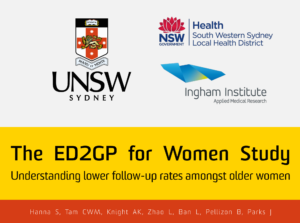 This oral presentation was delivered at the Health Beyond Research & Innovation Showcase 2019 conference, at The William Inglis – MGallery by Sofitel, Sydney, on 6 June 2019. (Abstract : Slides)
This oral presentation was delivered at the Health Beyond Research & Innovation Showcase 2019 conference, at The William Inglis – MGallery by Sofitel, Sydney, on 6 June 2019. (Abstract : Slides)
Hanna S, Tam CWM, Knight A, Zhao L, Ban L, Pellizzon B, Parks J. The ED2GP for women study: understanding lower follow-up rates amongst older women. Health Beyond Research & Innovation Showcase 2019 conference, The William Inglis – MGallery by Sofitel, Sydney. 2019 June 6.
ABSTRACT
BACKGROUND AND OBJECTIVES
Older women seem to have lower general practitioner (GP) follow-up rates after an emergency department (ED) discharge than men. Some studies have described factors related to the transition of care from the ED to general practice amongst older persons, but none amongst older women in particular. In the ED2GP for women study, we sought to investigate this phenomenon in a suburban hospital in Fairfield Hospital (South Western Sydney, NSW, Australia). A secondary outcome was to measure the proportion of older women who had followed up with a GP by day seven after discharge from the ED.
METHODS
In this predominantly qualitative study, women over the age of 65 were recruited from the ED and included in the study if they were discharged into the community with an explicit GP follow-up instruction. A verbal structured questionnaire was undertaken during the ED visit, followed by a telephone structured and semi-structured interview undertaken between days 8 to 14 after discharge exploring factors associated with their follow-up behaviour. Participant demographic details were taken from the ED electronic health record system. Grounded theory was used to analyse qualitative data and exploratory statistical analyses conducted to identify potential explanatory factors.
RESULTS
100 women were recruited in this study (mean age=77). 67% spoke a language other than English at home, and more than half were unmarried. 64% of women followed up with a GP by day seven, and only 50% followed up in direct accordance with ED instructions. The perceived cost and benefit of general practitioner follow-up emerged as a useful model to understand how factors influenced follow-up behaviour. Factors influencing the perceived cost of follow-up included the inconvenience caused to self, access to transport options, the perceived inconvenience posed to others, and the availability of the patient’s general practitioner. Factors influencing the perceived benefit of follow-up included their previous experiences with the healthcare system, their pre-existing health-seeking behaviours, and ED messaging.
DISCUSSION
Follow-up rates amongst older women can be achieved by both increasing the perceived benefit of general practitioner follow-up at the point of ED discharge, in addition to focussing on decreasing the costs associated with follow-up. These approaches may include ensuring that discharge instruction given from the ED is motivating, clearly communicated, and given in the company of family or friends that the patient is dependent upon. There is also a need for GP home visits to immobilised members of this population.

1 comments
Author
Mr Shaddy Hanna, a year 4 medical student on the UNSW Medicine program on his ILP (Independent Learning Project) who I am supervising, was awarded best presentation in the Community, Child, and Family Health session at the Health Beyond Research and Innovation Showcase.